CHAPTER 11 Establishing a Pay Structure
CHAPTER 11 Establishing a Pay Structure. fundamentals of Human Resource Management 4 th edition by R.A. Noe, J.R. Hollenbeck, B. Gerhart, and P.M. Wright. What Do I Need to Know?. Identify the kinds of decisions involved in establishing a pay structure.
Share Presentation
Embed Code
Link
Download Presentation
- pay
- overtime pay
- job evaluation
- pay structure
- job based pay
- green circle rate pay

lavonn + Follow
Download Presentation
CHAPTER 11 Establishing a Pay Structure
An Image/Link below is provided (as is) to download presentation Download Policy: Content on the Website is provided to you AS IS for your information and personal use and may not be sold / licensed / shared on other websites without getting consent from its author. Content is provided to you AS IS for your information and personal use only. Download presentation by click this link. While downloading, if for some reason you are not able to download a presentation, the publisher may have deleted the file from their server. During download, if you can't get a presentation, the file might be deleted by the publisher.
Presentation Transcript
- CHAPTER 11 Establishing a Pay Structure fundamentals ofHuman Resource Management 4theditionby R.A. Noe, J.R. Hollenbeck, B. Gerhart, and P.M. Wright
- What Do I Need to Know? • Identify the kinds of decisions involved in establishing a pay structure. • Summarize legal requirements for pay policies. • Discuss how economic forces influence decisions about pay. • Describe how employees evaluate the fairness of a pay structure.
- What Do I Need to Know? (continued) • Explain how organizations design pay structures related to jobs. • Describe alternatives to job-based pay. • Summarize how to ensure that pay is actually in line with the pay structure. • Discuss issues related to paying employees serving in the military and paying executives.
- 1-Strongly Disagree, 3-Neutral, 5- Strongly Agree Pay decisions should be based on performance, not seniority. I would like to know what my coworkers get paid. I would not mind if others knew my salary. Pay secrecy helps a company stay competitive. Your Opinion
- Introduction • Pay is a powerful tool for meeting the organization’s goals. • Pay has a large impact on employee attitudes and behaviors. • It influences the kinds of people who are attracted to (or remain with) the organization. • Employees attach great importance to pay decisions when they evaluate their relationship with their employer.
- Decisions About Pay
- Figure 11.1:Issues in Developing a Pay Structure
- Legal Requirements for Pay
- Legal Requirements for Pay:Equal Employment Opportunity • Employers must not base differences in pay on an employee’s age, sex, race, or other protected status. • Any differences in pay must be tied to such business-related considerations as job responsibilities or performance. • The goal is for employers to provide equal pay for equal work.
- Two employees who do the same job cannot be paid different wages because of gender, race, or age. • It would be illegal to pay these two employees differently because one is male and the other is female. • Only if there are differences in their experience, skills, seniority, or job performance are there legal reasons why their pay might be different.
- Legal Requirements for Pay:Minimum Wage • Minimum wage – the lowest amount that employers may pay under federal or state law, stated as an amount of pay per hour. • Fair Labor Standards Act (FLSA) – federal law that establishes a minimum wage and requirements for overtime pay and child labor.
- Minimum Wage (continued) • At the federal level, the FLSA establishes a minimum wage of: • $7.25 per hour as of July 2009 • The FLSA also permits a lower “training wage” • paid to workers under the age of 20 for up to 90 days • approximately 85 percent of the minimum wage
- Legal Requirements for Pay:Overtime Pay • The overtime rate under the FLSA is 1½ times the employee’s usual hourly rate, including any bonuses, and piece-rate payments. • Exempt employees – managers, outside salespeople, and other employees not covered by the FLSA requirement for overtime pay. • Nonexempt employees – employees covered by the FLSA requirements for overtime pay.
- Figure 11.2: Computing Overtime Pay
- Overtime Pay (continued)
- Legal Requirements for Pay:Child Labor • Children aged 16 and 17 may not be employed in hazardous occupations defined by the U.S. Department of Labor. • Children aged 14 and 15 may work only outside school hours, in jobs defined as nonhazardous, and for limited time periods. • A child under age 14 may not be employed in any work associated with interstate commerce. • Exemptions include baby-sitting, acting, and delivering newspapers.
- Legal Requirements for Pay:Prevailing Wages • Two federal laws govern pay policies of federal contractors: • Davis-Bacon Act of 1931 • Walsh-Healy Public Contracts Act of 1936 • Under these laws, federal contractors must pay their employees at rates at least equal to the prevailing wages in the area.
- Economic Influences on Pay Product Markets Labor Markets Organizations must compete to obtain human resources in labor markets. Competing for labor establishes the minimum an organization must pay to hire an employee for a particular job. • The organization’s product market includes organizations that offer competing goods and services. • Organizations compete on quality, service, and price. • The cost of labor is a significant part of an organization’s costs.
- There is currently a strong demand for nurses in the labor market. Hospitals will have to pay competitive wages and other perks to attract and retain staff.
- Tech Workers Out-Earn Managers
- Pay Level: Deciding What to Pay
- Gathering Information About Market Pay • Benchmarking – a procedure in which an organization compares its own practices against those of successful competitors • Pay surveys • Trade and industry groups • Professional groups • Bureau of Labor Statistics (BLS) • Society for Human Resource Management (SHRM) • WorldatWork
- Employee Judgments About Pay Fairness • Employees compare their pay and contributions against three yardsticks: • What they think employees in other organizations earn for doing the same job. • What they think other employees holding different jobs within the organization earn for doing work at the same or different levels. • What they think other employees in the organization earn for doing the same job as theirs.
- Figure 11.3: Opinions About Fairness – Pay Equity
- Pay Equity (continued) • If employees conclude that they are under-rewarded, they are likely to make up the difference in one of three ways: • They might put forth less effort (reducing their inputs). • They might find a way to increase their outcomes (e.g., stealing). • They might withdraw (by leaving the organization or refusing to cooperate). • Employees’ beliefs about fairness also influence their willingness to accept transfers or promotions.
- Mariah found out that a friend of hers with a similar job in the same town makes significantly more money than she does. Which of the following is probably not the cause of this? Different cost-of-living The companies are in different product markets with different pay strategies Mariah is a poor performer Mariah’s job is non-exempt Test Your Knowledge
- Job Structure: Relative Value of Jobs Job Evaluation Compensable Factors The characteristics of a job that the organization values and chooses to pay for. Experience Education Complexity Working conditions Responsibility • An administrative procedure for measuring the relative internal worth of the organization’s jobs.
- Table 11.1: Job Evaluation of Three Jobs with Three Compensable Factors
- Job Structure: Defining Key Jobs • Key Jobs – jobs that have relatively stable content and are common among many organizations. • Organizations can make the process of creating the job structure and the pay structure more practical by defining key jobs. • Research for creating the pay structure is limited to the key jobs that play a significant role in the organization.
- Pay Structure: Putting It All Together
- Pay Rates
- Figure 11.4: Pay Policy Lines Pay policy line – a graphed line showing the mathematical relationship between job evaluation points and pay rate.
- Figure 11.5: Sample Pay Grade Structure Pay grades –sets of jobs having similar worth or content, grouped together to establish rates of pay.
- Pay Ranges • Pay ranges – a set of possible pay rates defined by a minimum, maximum, and midpoint of pay for employees holding a particular job or a job within a particular pay grade. • Red-circle rate –pay at a rate that falls above the pay range for the job. • Green-circle rate –pay at a rate that falls below the pay range for the job.
- To correct a Red-circled employee, I would… Give them a raise Demote them Give them a bonus, but no raise Move them to a job with a higher pay range Test Your Knowledge
- Pay Differentials • Pay differential – adjustment to a pay rate to reflect differences in working conditions or labor markets. • Many businesses in the United States provide pay differentials based on geographic location. • The most common approach is to move an employee higher in the pay structure to compensate for higher living costs.
- Night hours are less desirable for most workers. Therefore, some companies pay a differential for night work to compensate them.
- Alternatives to Job-Based Pay Delayering Skill-Based Pay Systems Pay structures that set pay according to the employees’ levels of skill or knowledge and what they are capable of doing. This is appropriate in organizations where changing technology requires employees to continually widen and deepen their knowledge. • Reducing the number of levels in the organization’s job structure. • More assignments are combined into a single layer. • These broader groupings are called broad bands. • More emphasis on acquiring experience, rather than promotions.
- Figure 11.6:IBM’s New Job Evaluation Approach
- Pay Structure and Actual Pay • Pay structure represents the organization’s policy. • However, what the organization actually does may be different. • The HR department should compare actual pay to the pay structure, making sure that policies and practices match. • Compa-ratiois the common way to do this.
- Figure 11.7: Finding a Compa-Ratio • Compa-Ratio (CR) – the ratio of average pay to the midpoint of the pay range. • If the average equals the midpoint, CR is 1. • If CR is greater than 1, the average pay is above the midpoint. • IF CR is less than 1, the average pay is below the midpoint.
- Pay During Military Duty How should companies handle employees who are called for active duty in the military for extended time periods? The Uniformed Services Employment and Reemployment Rights Act (USERRA) Pay for Executives Based on equity theory, how does executive compensation affect employees? Current Issues in Pay
- Figure 11.8: Average CEO Pay in S&P 500 Companies Bonus
- Summary • Organizations make decisions to define a job structure, or relative pay for different jobs within the organization. Organizations also must establish pay levels, or the average paid for the different jobs. • These decisions are based on the organization’s goals, market data, legal requirements, and principles of fairness. • Together, job structure and pay level establish a pay structure policy.
- Summary • To meet the standard of equal employment opportunity, employers must provide equal pay for equal work, regardless of an employee’s age, race, sex, or other protected status. • Differences in pay must relate to factors such as a person’s qualifications or market levels of pay. • Under the Fair Labor Standards Act (FLSA): • The employer must pay at least the minimum wage established by law. • Overtime pay for hours worked beyond 40 in each week must be paid.
- Summary (continued) • To remain competitive, employers must meet the demands of the product and labor markets. • Limit their costs as much as possible. • Pay at least the going rate in their labor markets. • According to equity theory, employees think of their pay relative to their inputs – training, experience, and effort. • To decide whether their pay is equitable, they compare their outcome (pay)/input ratio with other people’s outcome/input ratios.
- Summary (continued) • The traditional approach to building a pay structure is to use a job-based approach. • Alternatives to the traditional approach include broad banding and skill-based pay. • The Uniformed Services Employment and Reemployment Rights Act (USERRA) requires employers to make jobs available to any of their employees who leave to fulfill military duties for up to five years.
- Summary (continued) • Executive pay has drawn public scrutiny because top executive pay is much higher than average workers’ pay. • The great difference is an issue in terms of equity theory. • Employees’ opinions about the equity of executive pay can have a large effect on the organization’s performance.
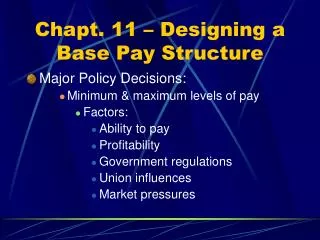
Chapt. 11 – Designing a Base Pay Structure
Chapt. 11 – Designing a Base Pay Structure . Major Policy Decisions: Minimum & maximum levels of pay Factors: Ability to pay Profitability Government regulations Union influences Market pressures. General relationships among pay levels Non-exempt vs. exempt
627 views • 22 slides

Establishing Strategic Pay Plans
Establishing Strategic Pay Plans. Presented to: Sir Ahmad Tisman pasha. Presented by: Saima Asghar Roll no: 07-20(bsit 3 rd ) Department of Computer science. Bahuddin Zakariya University Multan. Establishing Pay Rates. Step 1. The salary survey
738 views • 39 slides

Chapter 11 Establishing Rewards and Pay Plans
Fundamentals of Human Resource Management Eighth Edition DeCenzo and Robbins. Chapter 11 Establishing Rewards and Pay Plans. Introduction. People do what they do to satisfy some need and they look for a payoff or reward. The most obvious reward is pay, but there are many others, including:
1.22k views • 37 slides
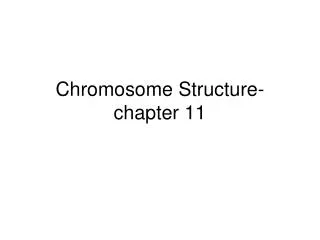
Chromosome Structure- chapter 11
Chromosome Structure- chapter 11. Where we’re going. Do some math on DNA- lengths. Tour of a few types of chromosomes Endosymbiosis Some time spent on Eukaryotic chromosome structure Some repetitive DNA types. I. The problem: DNA is LONG:.
535 views • 18 slides

Membrane Structure Chapter 11
Membrane Structure Chapter 11. Questions in this chapter you should be able to answer: Chapter 11- #s1 - 20. Membranes are described as a “2-dimensional liquid”. Why?. Jmol Membrane model. Laser tweezers. Membrane fluidity. How can we measure membrane fluidity?
370 views • 14 slides
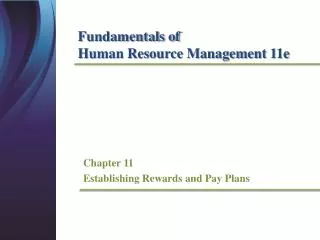
Chapter 11 Establishing Rewards and Pay Plans
Chapter 11 Establishing Rewards and Pay Plans. Introduction. What is your biggest motivator at work? Promotions Great work assignments Recognition Control over your own work? Pay – covered in this chapter. Extrinsic. Intrinsic. Financial. Non-financia l. participation in
1.64k views • 25 slides

User Interface Structure Design Chapter 11
User Interface Structure Design Chapter 11. Alan Dennis, Barbara Wixom, and David Tegarden John Wiley & Sons, Inc. Slides by Fred Niederman Edited by Solomon Negash. Key Definitions. The user interface defines how the system will interact with external entities
550 views • 27 slides
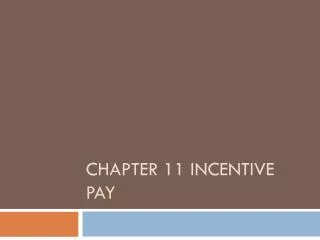
Chapter 11 Incentive Pay
Chapter 11 Incentive Pay. Incentive pay. A compensation package designed to elicit particular levels of effort from the worker Goal: to maximize productivity while simultaneously minimizing costs (labor costs here). Labor Contracts v. Spot Markets.
383 views • 19 slides

Chapter 11: Storage and File Structure
Chapter 11: Storage and File Structure. Chapter 11: Storage and File Structure. Overview of Physical Storage Media Magnetic Disks RAID Tertiary Storage Storage Access File Organization Organization of Records in Files Data-Dictionary Storage
1.1k views • 85 slides
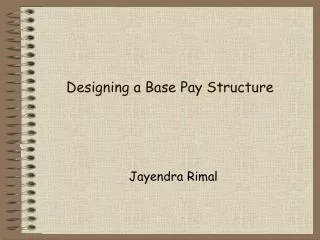
Designing a Base Pay Structure
Designing a Base Pay Structure. Jayendra Rimal. Introduction. Strategy: Develop a link between work required, performance demonstrated and pay provided to each employee. Guidelines for developing pay structures:
521 views • 8 slides

CHAPTER 11 ESTABLISHING A PAY STRUCTURE
Fundamentals of human resource management 5 th edition By R.A. Noe, J.R. Hollenbeck, B. Gerhart, and P.M. Wright. CHAPTER 11 ESTABLISHING A PAY STRUCTURE. Decisions About Pay. Legal Requirements for Pay: Equal Employment Opportunity.
1.19k views • 10 slides
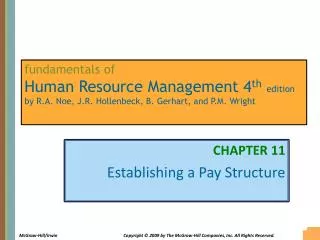
CHAPTER 11 Establishing a Pay Structure
CHAPTER 11 Establishing a Pay Structure. fundamentals of Human Resource Management 4 th edition by R.A. Noe, J.R. Hollenbeck, B. Gerhart, and P.M. Wright. Figure 11.1: Issues in Developing a Pay Structure. Legal Requirements for Pay: Equal Employment Opportunity.
550 views • 14 slides

Chapter 11 establishing a pay structure
Chapter 11 establishing a pay structure. Fundamentals of human resource management 5 th edition By R.A. Noe, J.R. Hollenbeck, B. Gerhart, and P.M. Wright. Need to Know. K inds of decisions involved in establishing a pay structure. L egal requirements for pay policies.
985 views • 47 slides

Chapter 11: Storage and File Structure
Chapter 11: Storage and File Structure. 11.1 Overview of physical storage media 11.2 Magnetic disks 11.3 RAID 11.4 Tertiary access 11.5 Storage access 11.6 File organization 11.7 Organization of records in files 11.8 Data dictionary storage
438 views • 27 slides

Chromosome Structure- Chapter 11
Chromosome Structure- Chapter 11. Where we’re going. Do some math on DNA- lengths. Tour of a few types of chromosomes Endosymbiosis Some time spent on Eukaryotic chromosome structure Some repetitive DNA types Some new information about Epigenetics. I. The problem: DNA is LONG:.
341 views • 22 slides

Chapter 11: Storage and File Structure
Chapter 11: Storage and File Structure. Chapter 11: Storage and File Structure. Overview of Physical Storage Media Magnetic Disks RAID Tertiary Storage Storage Access File Organization Organization of Records in Files Data-Dictionary Storage
871 views • 85 slides
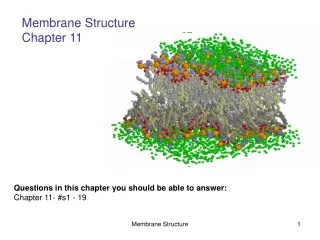
Membrane Structure Chapter 11
Membrane Structure Chapter 11. Questions in this chapter you should be able to answer: Chapter 11- #s1 - 19. Membranes are described as a “2-dimensional liquid”. Why?. Jmol membrane model. Laser Tweezers. Membrane Fluidity. How can we measure membrane fluidity?
170 views • 14 slides
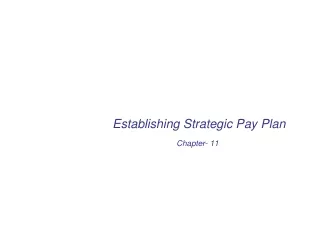
Establishing Strategic Pay Plan Chapter- 11
Establishing Strategic Pay Plan Chapter- 11. Basic Factors. Employee compensation All forms of pay or rewards going to employees and arising from their employment. Direct financial payments Pay in the form of wages, salaries, incentives, commissions, and bonuses.
439 views • 30 slides

MGT-351 Human Resource Management Chapter-11 Establishing Strategic Pay Plans
MGT-351 Human Resource Management Chapter-11 Establishing Strategic Pay Plans. Employee Compensation. Direct Financial Payments. Indirect Financial Payments. Basic Factors in Determining Pay Rates. Corporate Policies, Competitive Strategy, and Compensation. Aligned Reward Strategy
681 views • 22 slides

Chapter 11: Designing Organizational Structure
Chapter 11: Designing Organizational Structure. Text by Charles W. L. Hill Gareth R. Jones. Multimedia Slides by Milton M. Pressley Univ. of New Orleans. Preview. The Role of Organizational Structure Vertical Differentiation Horizontal Differentiation
708 views • 45 slides






















